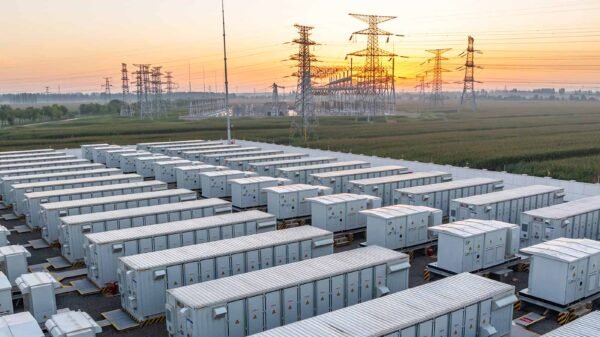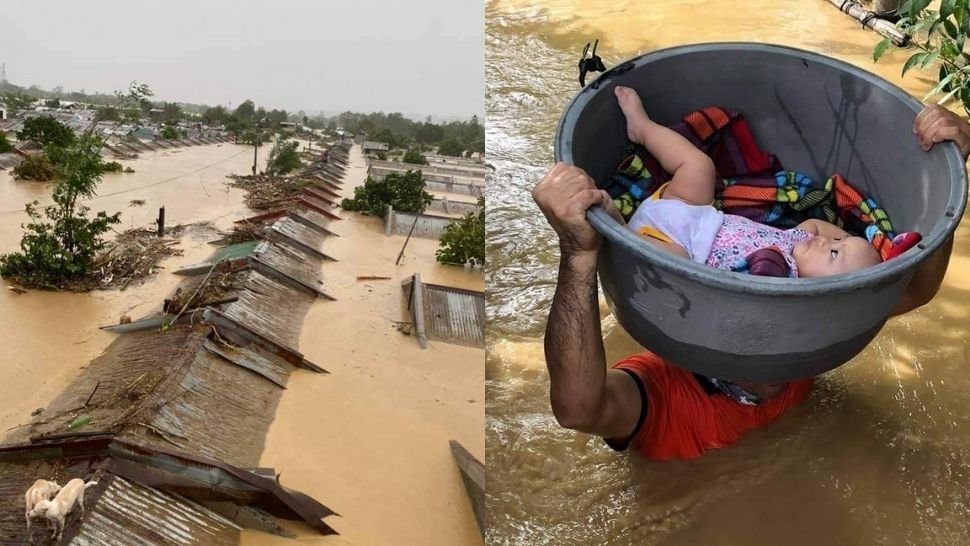Introduction
The Philippines is currently grappling with the devastating impact of Typhoon Gaemi, which has exacerbated the already intense monsoon rains, leading to severe flooding in the nation’s capital. The unprecedented deluge has caused widespread devastation, disrupting daily life and prompting urgent calls for climate action. The heavy rains have not only inundated urban areas but have also triggered landslides in the more mountainous regions, compounding the disaster’s severity. Amidst this turmoil, an oil tanker has capsized, creating a potential environmental crisis with the threat of oil spills contaminating local ecosystems.
As the capital city finds itself submerged, thousands of residents have been displaced, seeking refuge in temporary shelters. Infrastructure has taken a significant hit, with roads, bridges, and public transport systems rendered inoperable. The economic implications are profound, affecting both local businesses and the broader national economy. The flooding has also disrupted essential services, including healthcare and emergency response, further complicating relief efforts.
The sinking of the oil tanker adds another layer of complexity to the unfolding catastrophe. The vessel’s cargo poses a serious risk to marine and coastal environments, as well as to the livelihoods of communities dependent on fishing and tourism. Emergency teams are working around the clock to contain the spill and mitigate its impact, but the scale of the challenge is immense.
Typhoon Gaemi and Its Impact
Typhoon Gaemi, a formidable storm system, carved a path of destruction as it made landfall in the Philippine capital. The typhoon intensified pre-existing monsoon conditions, resulting in unprecedented rainfall and widespread flooding. Initial meteorological data indicated that Gaemi was a Category 3 typhoon, with sustained wind speeds of 120 kilometers per hour and gusts reaching up to 150 kilometers per hour. The storm’s trajectory took it across densely populated urban areas, exacerbating the already severe weather conditions.
The Philippines, frequently vulnerable to natural disasters, experienced heightened levels of precipitation due to Typhoon Gaemi. According to the Philippine Atmospheric, Geophysical and Astronomical Services Administration (PAGASA), the typhoon dumped over 300 millimeters of rain within a span of 24 hours, overwhelming drainage systems and causing rivers to overflow. This deluge led to significant flooding in both residential and commercial zones, displacing thousands of residents and causing extensive property damage.
Experts noted that the interaction between Gaemi and the southwest monsoon, known locally as the “habagat,” intensified the storm’s impact. The monsoon, already active during the typhoon’s arrival, was further fueled by the storm’s moisture, leading to continuous heavy rains. Meteorologists highlighted the phenomenon of “rainfall enhancement,” where the monsoonal rains were significantly amplified by the typhoon’s presence, resulting in the extreme weather conditions observed.
Extent of Flooding in the Philippine Capital
The recent typhoon has resulted in extensive flooding across the Philippine capital, devastating numerous communities and displacing thousands of residents. According to the latest statistics, floodwaters have reached unprecedented levels, submerging entire neighborhoods and rendering major roads impassable. Official reports indicate that over 70% of the capital’s districts are affected, with some areas experiencing water levels as high as six feet.
The impact on the population has been profound, with an estimated 200,000 people either trapped in their homes or forced to evacuate to temporary shelters. Emergency services are overwhelmed as they strive to reach stranded individuals, and rescue operations are ongoing despite challenging conditions. The city’s infrastructure has also taken a severe hit; power outages are widespread, and water supply systems have been disrupted, compounding the difficulties faced by residents.
Among the hardest-hit areas is Marikina City, where the rapid rise of the Marikina River has led to substantial flooding. Residents recount harrowing experiences of fleeing their homes in the dead of night, with little more than the clothes on their backs. One resident, Maria Santos, shared, “We woke up to water rushing into our house. We had to climb onto the roof to escape. It was terrifying.” Similarly, in Pasig City, the inundation has left entire communities isolated, with limited access to emergency aid.
Casualties and Displacement
The recent typhoon that struck the Philippine capital has resulted in unprecedented human suffering. Tragically, the disaster has claimed numerous lives, with the death toll continuing to rise as rescue operations uncover more victims. Initial reports indicate that hundreds have perished, while countless others have sustained severe injuries requiring immediate medical attention. Emergency services are overwhelmed, struggling to provide timely assistance amidst the chaos.
In addition to the fatalities and injuries, the typhoon has displaced an overwhelming number of residents. Current estimates suggest that over 600,000 people have been forced to flee their homes, seeking refuge in temporary shelters. These shelters, however, are often inadequate, lacking essential resources to meet the basic needs of the displaced population. Overcrowding and unsanitary conditions pose significant risks, exacerbating the already dire situation.
The displaced individuals face an array of immediate needs. Access to clean water, food, and medical supplies is critically limited, leading to heightened concerns over potential outbreaks of waterborne diseases and malnutrition. The psychological impact of such a disaster cannot be underestimated, as survivors grapple with the trauma of losing loved ones and their homes. Mental health support is urgently required to help them cope with their harrowing experiences.
The challenges in addressing these needs are manifold. Logistics remain a major hurdle, with damaged infrastructure impeding the delivery of aid. Roads and bridges have been washed away, complicating efforts to reach affected areas. Furthermore, coordination between various aid agencies and government bodies must be improved to ensure efficient distribution of resources. The enormity of the disaster has also strained financial resources, highlighting the need for international assistance and solidarity.
Oil Tanker Capsize and Environmental Concerns
The recent capsizing of an oil tanker off the coast of the Philippines has added another layer of urgency to the ongoing climate crisis. The tanker, carrying a significant volume of oil, succumbed to the severe weather conditions brought about by the deadly typhoon. The inclement weather, characterized by heavy rainfall and strong winds, overwhelmed the vessel, leading to its unfortunate downfall. This incident has raised grave concerns regarding the immediate and long-term environmental impacts.
In the immediate aftermath, the capsizing resulted in a considerable oil spill, which began to spread rapidly across the surrounding waters. Oil spills are notoriously difficult to contain and can wreak havoc on marine ecosystems. The spilled oil creates a slick on the water’s surface, obstructing sunlight and oxygen from reaching aquatic life underneath. This can result in the death of fish, corals, and other marine organisms, creating a cascade of negative effects throughout the food chain.
Beyond the immediate impacts, the potential long-term environmental consequences are equally troubling. Oil residues can persist in marine environments for years, continuing to affect wildlife and habitats long after the initial spill. Furthermore, the toxic components of oil can bioaccumulate in marine organisms, leading to prolonged health issues and reproductive failures. Coastal communities, reliant on fishing and tourism, may also suffer economically from the degradation of their natural resources.
In response, authorities have initiated containment and cleanup operations. Specialized teams are working to deploy booms and skimmers to limit the spread of the oil and recover as much of it as possible. However, given the scale of the spill and the challenging weather conditions, these efforts face significant obstacles. There is also a pressing need for comprehensive environmental monitoring to assess the full extent of the damage and guide future remediation efforts.
Government and International Response
The Philippine government has promptly activated its disaster response protocols in the wake of the catastrophic flooding and oil tanker sinking caused by the deadly typhoon. President Ferdinand Marcos Jr. has declared a state of calamity in the affected regions, which enables the rapid mobilization of funds and resources to support emergency measures. The National Disaster Risk Reduction and Management Council (NDRRMC) has been working around the clock to coordinate rescue operations, deploy relief goods, and ensure the safety of residents in the inundated areas.
International aid organizations have also stepped in to offer assistance. The United Nations has pledged emergency funds and sent humanitarian teams to assess the damage and provide essential supplies such as food, clean water, and medical aid. Various non-governmental organizations (NGOs), including the Red Cross and Doctors Without Borders, are actively participating in relief efforts, focusing on delivering immediate aid to the most vulnerable populations.
Coordination between local, national, and international agencies has been crucial in maximizing the effectiveness of these efforts. The Philippine government has established a centralized command center to streamline communication and response activities. This hub facilitates real-time data sharing and decision-making, which is vital for efficient disaster management. The Armed Forces of the Philippines (AFP) and the Philippine Coast Guard (PCG) have been instrumental in conducting search and rescue operations, particularly in hard-to-reach areas.
Calls for Climate Action
The recent devastation caused by the typhoon in the Philippines has reignited calls for stronger climate action. Climate activists, scientists, and policymakers are urging for immediate and more robust measures to address the escalating threats posed by climate change. This catastrophic event underscores the urgent need for a global commitment to mitigate the impacts of climate change and adapt to its inevitable consequences.
Climate activists have been vocal in their demands for urgent action. Maria Santos, a prominent environmental advocate, emphasized the need for “systemic changes in energy policies, reduction of greenhouse gas emissions, and investment in renewable energy sources to prevent future disasters.” Her sentiments are echoed by numerous environmental organizations that stress the importance of transitioning to sustainable practices to protect vulnerable communities.
Scientists have long warned about the increasing frequency and intensity of extreme weather events due to climate change. Dr. Enrique Martinez, a climatologist, noted that “the typhoon’s severity is a stark reminder of the consequences of global warming. It is imperative that we bolster our climate resilience and reduce our carbon footprint to mitigate these impacts.” His research highlights the correlation between rising global temperatures and the occurrence of severe weather patterns, making it clear that immediate action is necessary.
Policymakers are also recognizing the need for comprehensive climate policies. Senator Juan dela Cruz, in a recent statement, called for “the implementation of stricter environmental regulations and international cooperation to combat climate change.” He stressed that the Philippines, being one of the most climate-vulnerable countries, must lead by example in advocating for stronger climate commitments on the global stage.
Conclusion and Future Outlook
The recent events in the Philippines serve as a stark reminder of the devastating impacts that natural disasters can have on both human life and infrastructure. The deadly typhoon that led to severe flooding in the capital and the sinking of an oil tanker underscores the urgent need for strengthened disaster preparedness and mitigation strategies. The immediate implications of this disaster are profound, with thousands displaced, homes destroyed, and critical environmental damage due to the oil spill.
In the long-term, the Philippines must prioritize building resilient infrastructure and enhancing its disaster response systems to better withstand future calamities. This includes investing in early warning systems, flood defenses, and sustainable urban planning that can mitigate the effects of extreme weather events. Additionally, the importance of community-based disaster risk reduction cannot be overstated; empowering local communities with the knowledge and tools to respond effectively is crucial.
Moreover, this disaster highlights the critical need for global cooperation in addressing the root causes of climate change. As typhoons and other extreme weather events become more frequent and intense due to climate change, international collaboration on emission reductions and sustainable practices becomes imperative. The Philippines, along with other vulnerable nations, must advocate for stronger global commitments to climate action to ensure a safer and more sustainable future.



































